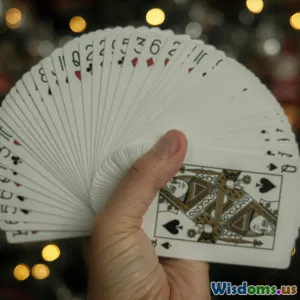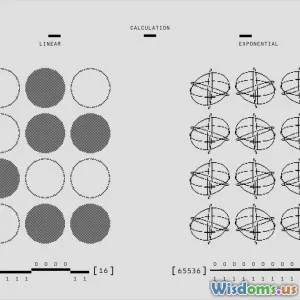
Avoiding Common Magic Slip Ups Lessons From Top Illusionists
8 min read Discover how top illusionists avoid magic slip-ups and enhance performance with expert lessons and practical tips. (0 Reviews)
Avoiding Common Magic Slip Ups: Lessons From Top Illusionists
Magic is an art of wonder, mystery, and flawless execution. Whether you’re a seasoned performer or a beginner eager to dazzle, avoiding common slip-ups is essential to maintaining the magic's illusion and captivating the audience. According to renowned illusionist David Copperfield, "Magic is not just about tricking the eye but mastering control over every detail behind the scenes."
In this article, we will delve into the frequent mistakes many magicians encounter and how top illusionists circumvent these pitfalls. Through real-world examples, techniques, and psychological insights, you'll learn actionable strategies to polish your craft and keep your performances flawless.
Understanding Magic Slip-Ups: The Cost of Imperfection
Magic slip-ups, whether a forgotten move, accidental exposure of a secret, or timing errors, break the audience's suspension of disbelief. These errors; diminish the overall experience and can tarnish a magician's reputation.
Common Types of Slip-Ups
-
Revealing Secret Mechanisms: The accidental display of a prop’s inner workings that ruin the mystery.
-
Timing and Pacing Errors: Rushing through a performance or lingering too long can make tricks seem cluttered or expose the setup.
-
Misdirecting Ineffectively: Poor distractive techniques that fail to shift audience focus from the critical move.
-
Technical Mishaps: Faulty props, dropped cards, or tangled ropes interrupting flow.
-
Over-explanation or Redundancy: Diluting the effect by telling too much or repeating elements undermine the magic.
A key insight comes from Dai Vernon, the "Professor," a legend in sleight of hand. He said, "The secret lies not in a clever trick, but in not getting caught doing it wrong."
Lessons from the Masters: How Top Illusionists Avoid Slip-Ups
1. Rigorous Practice and Rehearsal
Penn & Teller emphasize relentless rehearsal to minimize errors. Before public performances, they test tricks extensively to uncover inconsistencies or weaknesses. This rigorous practice ingrains muscle memory, reducing chances of slips during live shows.
For example, Penn maintains a "practice journal" meticulously logging hours practiced and errors corrected, enabling targeted improvement.
2. Simplification and Streamlining
Top illusionists often strip tricks to their most elegant form. David Blaine’s street magic showcases how minimal props paired with engaging storytelling can overshadow complex mechanisms, reducing mishaps.
Simplifying ensures each step flows naturally and the chances of technical failure diminish.
3. Mastering Misdirection Techniques
Effective misdirection is the backbone of escape from exposure. Houdini’s performances demonstrated not just flashy escapes but perfectly timed distractions that kept all eyes where he wanted.
Modern experts like Derren Brown blend body language, verbal cues, and silence to skillfully divert attention. Sessions of studying human cognition and psychology allow them to predict where audience focus will lie, minimizing unintentional reveals.
4. Having Backup Plans
Bruce Cervon, a famous entertaining magician and trainer, advises having contingency plans for every routine. This can range from alternative gestures to recover from mishandled card slips or engaging sideline chatter if a prop fails.
Cervon's workshops teach magicians improvisational skills, making them resilient in potential slip-up scenarios.
5. Controlling the Environment
Illusionists like Criss Angel ensure full control over lighting, audience distance, and timing. Environmental control removes variables that could cause slips such as glare revealing secret compartments or audience proximity leading to unintentional sightings.
Taking command of stage conditions stabilizes the performance landscape, enabling smoother routines.
Real-World Case Studies: Learning from Slip-Ups
Case Study 1: The Vanishing Coin Fumble
In a televised magic show, a magician accidentally showed the coin in his palm immediately after pretending to vanish it. The result was instantaneous audience disbelief.
Lessons: This highlights the importance of hand positioning and timing. Lesson shared by professional sleight artist Michael Ammar emphasizes training in natural hand movements to avoid unnatural reveals.
Case Study 2: The Rope Escape Oversight
An illusionist's rope escape was unraveling too early on stage because the concealed cuts in the rope were too obvious under stage lighting.
Response: Post-mistake, the performer refined the rope's design, shielding cuts with special materials and adjusting lighting angles. This matches David Copperfield’s advice on controlling environmental variables.
Case Study 3: Over-Telling the Trick
A young magician kept explaining the trick’s "illusion" part during the performance, breaking suspense and revealing too much.
Resolution: Mentor magicians recommend trimming dialogue to essential storytelling, maintaining an air of mystery — proven methods in the field prioritize performance over explanation.
Practical Tips for Magicians: Avoid Your Next Slip-Up
1. Record Your Practices: Self-review helps detect awkward moments or potentially revealing movements.
2. Engage in Mock Performances: Testing tricks in front of a test audience can reveal unexpected slip-up triggers.
3. Train Peripheral Awareness: Maintaining awareness of all prop positions, audience angles, and hand movements reduces accidental exposure.
4. Focus on Pacing: Balance can captivate. A stopwatch read through each routine during practice to optimize timing.
5. Learn Psychological Misdirection: Study distraction techniques beyond mere gestures; use voice, gaze, and narrative timing to shift focus.
6. Maintain Physical Condition: Fatigue can cause errors; ensure you’re physically prepared and well-rested.
7. Choose High-Quality Props: Faulty equipment greatly raises the odds of technical failures.
Conclusion: Embracing Flawlessness Through Preparation and Mindfulness
Top illusionists demonstrate that avoiding magic slip-ups is a blend of extensive practice, effective misdirection, environmental control, and psychological insight. While mistakes can happen, they teach resilience and growth.
Every magic performer, novice or expert, can borrow from these lessons to enhance their craft. Remember, as Ricky Jay, one of the great card magicians said, "Mastery is not perfection; it's being prepared for imperfection."
By integrating the insights and techniques shared here, your magic will not only become more polished but also expand your creative horizons—ensuring every performance leaves audiences truly spellbound.
References
- Copperfield, David. David Copperfield's Tales of the Impossible. Book.
- Vernon, Dai. The Dai Vernon Book of Magic.
- Ammar, Michael. Easy to Master Card Miracles.
- Cervon, Bruce. Seminar Notes on Magic Practice and Improvisation.
- Interviews and Lectures from Penn & Teller, Derren Brown, and Criss Angel (various sources).
Rate the Post
User Reviews
Other posts in Legendary Magic Failures and Mishaps
Popular Posts
















